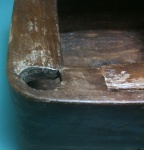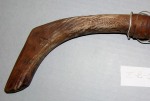Under Construction, August 2011
1. BACKGROUND
A huge range of wooden artifacts are found in Alaskan collections. These range from waterlogged archaeological remains, to traditional Native feast dishes and tools, to picture frames, furniture and fine carvings.
2. POSSIBLE CAUSES
The most common white stuff we have seen on Alaskan wooden artifacts are fatty bloom, dust, mold, paint spatters, polyethylene glycol treatment, insect debris (such as frass) and pesticides.
Bloom
When seeing fuzzy white growth on an object, people’s initial assumption is often that it is a mold or mildew. But this is not always the case. Blooms can sometimes have a feathery or matted fibrous look similar to mold, but microscopic examination and solubility tests can confirm the presence (or absence) of bloom. White bloom resulting from fats, oils and waxes in wooden materials may be referred to in literature as ‘fatty bloom,’ ‘fat bloom,’ or ‘fatty spew (or spue). These terms all refer to the formation of crystals on the surface that form from fats or oils either applied to the surface or left as residues from use.
Bloom on wooden artifacts is caused by the application of fats and oils to the surface or from residues left behind from use. There are a number of hypotheses regarding the exact mechanism of the formation of these blooms. Some attribute it to free fatty acids that separate out and crystallize on the surface.(Ordonez and Twilley 1998, 3-4). Analysis by Scott R. Williams (1988, 65-84) found bloom on objects to be primarily composed of a variety of fatty acids including palmitic, stearic, myristic and dicarboxylic acids (such as azelaic). These were present individually or occasionally as mixtures; however palmitic and stearic were the most commonly found (Williams 1988, 68-69). In general, however, it is believed that temperature and humidity levels play important factors in the migration and crystallization process.
Bloom can have a variety of appearances depending on the storage conditions, fats present in or on the object, and the type of material the bloom is forming on. It can appear powdery, granular, or branch-like. This makes it easily confused with other types of white stuff that can be found on objects. Throughout our survey, the most common type of bloom found on wood artifacts had a very crystalline, almost sugary appearance to it. In some cases it had been partially rubbed off the surface. A wide variety of wooden trays, bowls, dippers, ladles and spoons traditionally made by Alaska Native cultures were used in connection with animal oils such as seal oil or eulachon oil. These dishes often, but not always, have a darkened surface from the oil as well.
An important note is that fat bloom is often primarily found on areas of an object exposed to air. For example, on a leather-bound book the spine of the book (if it faces outward) may have the heaviest bloom. In some instances, it has been found that items closer to an air conditioning vent had a higher occurrence of bloom (Gottlieb 1982, 37) indicating that air circulation, temperature, and humidity play an important role.
Mold
Mold is typically described as having a fuzzy, velvety, or sometimes slimy appearance. When viewed under a microscope, the vegetative part of mold (known as mycelium http://en.wikipedia.org/wiki/Mycelium) can be seen as thin, thread-like branching hyphae and is very distinctive from the crystalline structure of salts. Mold growth generally begins to occur on organic materials when the environment is at 70% relative humidity or higher. The Canadian Conservation Institute (CCI) gives the following useful chart for mold growth on their “10 Agents of Deterioration” website http://www.cci-icc.gc.ca/crc/articles/mcpm/chap10-eng.aspx:
Pesticide Residue
Up until the late 20th century, the application of toxic pesticides to organic materials in museum collections was a widespread and accepted practice. Compounds made of arsenic or mercury were sometimes sprayed or dusted onto artifacts to prevent pest damage. DDT was also common as were moth balls comprised of dichlorobenzene or naphthalene. The carcinogenic and hazardous nature of these chemicals is now known and they are no longer used. However, the residues of past applications remain and they can sometimes show up as white residues that may be confused with other salt formations. On wood, pesticide residues may appear as a whitish, spotty haze over the surface of the object. When handling objects made of organic materials such as skin, it is always better to err on the side of caution and protect yourself from possible exposure to toxic chemicals. Wear protective gloves and a lab coat or apron. You may wish to wear a dust mask to prevent breathing in toxic dust.
Pests/Frass
Frass is the excrement passed by insects. It can be fine and powdery to grainy and pellet shaped in appearance. Frass often takes on the color of whatever substance has been eaten. In the case of light colored woods, if the frass is seen against a dark background, it can appear very light in color and might almost seem white or off-white. Yellow or beige may be more typical. One type of wood boring beetle is the Anobiid, also known as a powderpost beetle. These insects can be found tunneling their way through wood objects and leave behind frass that looks like tiny, lemon-shaped pellets. They are light tan in color, but may look whitish against a dark background. These insects were responsible for an extensive infestation of the Sheldon Jackson Museum collection many decades ago. More information on the Anobiids can be found on the museumpests.net website: http://www.museumpests.net/pdfholder/34image.pdf
3. REFERENCES
Mold hyphae, image by Bob Blaylock
Erickson, Harvey. (1977) Preservation of Wood Artifacts. Seattle, WA: University of Washington College of Forest Resources, October 1977.
Crista Pack’s notes: A very dated publication that reflects the acceptance and use of pesticides such as arsenate and boric acid compounds and DDT. Useful for its historical context to understand what may have been applied (and how) to wooden artifacts at that time. Erickson also discusses some different types of species (and their frass) that had been identified as potentially damaging to wood collections. The possible discoloration and efflorescence that may develop from application of the various pesticides is discussed; although the latter is not seen as a particular problem, but rather something that can simply “be largely removed by brushing and moist cloths.”
Geier, Katharina (2006) “A Technical Study of Arctic Pigments and Paint on Two 19th Century Yup’ik Masks.” Journal of the American Institute for Conservation. Vol 45 No 1 Spring 2006. Pp. 17-30
Ellen Carrlee’s notes: White pigments used on masks were identified as a mixture of clays, micas, and associated minerals, consistent with reportings in the ethnographic literature.
Ordonez, Eugenia and John Twilley, John. (1998) “Clarifying the Haze: Efflorescence on Works of Art” WAAC Newsletter 20 (1) 1998 pp 12-17.
Pearlstein, Ellen. “Fatty Bloom on Wood Sculpture from Mali.” Studies in Conservation 31 (1986) 83-91.
Crista Pack’s notes: describes the blooms found on African wooden objects. Results show that the bloom was the result of ethnographic application of oils. Examination techniques used include melting point, solubility behavior and infrared spectroscopy. States that sampling technique involved removing surface material with a fresh scalpel blade into a well slide. Provides a really good description of the bloom mechanism and polymorphism. Within conclusion, notes that “The surest way to eliminate the bloom entirely would be to remove all of the material causing it, which is neither simple on a porous wood sculpture, nor necessarily desirable if the material is a fat of ethnographic origin.” Also notes that the application of conservation waxes can interfere with identification and cause confusion because their chemical composition can be similar to fats. Gives really great technical data on the results of the fats analyzed, but these appear to be mainly of African origin. Oils in Alaskan wooden dishes are often of marine origin, including fish and marine mammals.
Williams, R. Scott. (1989) “Blooms, Blushes, Transferred Images and Mouldy Surfaces: What Are These Distracting Accretions on Art Works?” In Proceedings of the 14th Annual IIC-CG Conference 1988. Edited by Johanna G. Wellheiser. Ottawa. Pp. 65-84
4. EXAMPLES IN ALASKA




























